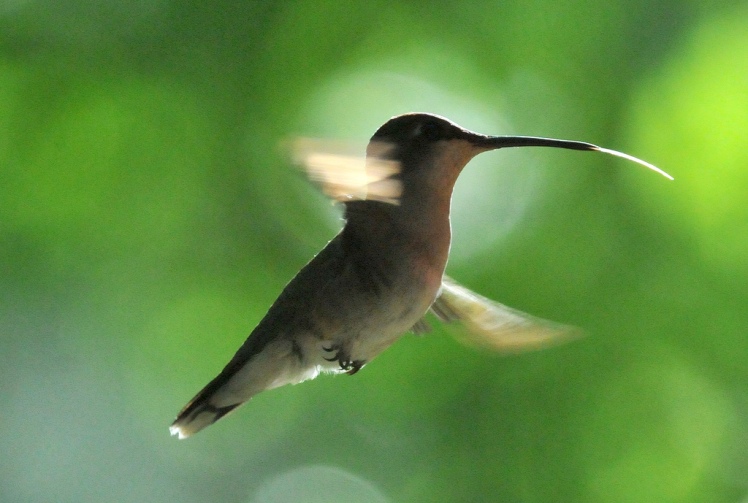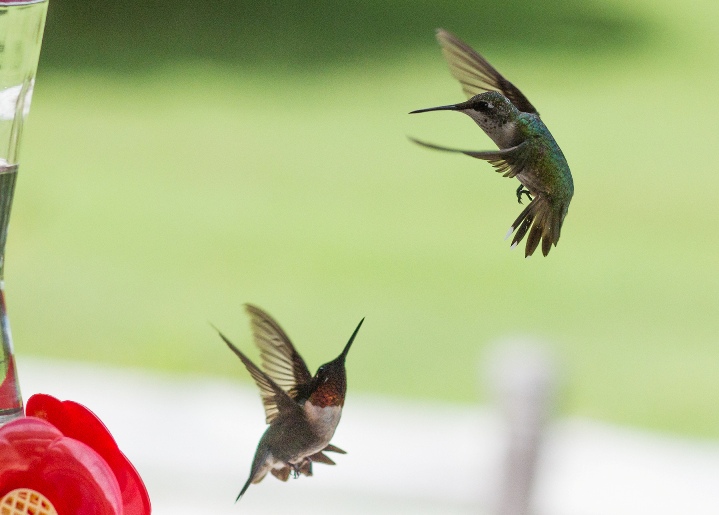 The two of us, my husband and I, took our breakfast toast, melon, and coffee out to the porch last Sunday morning, with late summer hanging on by its teeth. It was early, so the neighbors’ ACs were still off, and nobody was out yet. “It’s so quiet,” my husband said.
The two of us, my husband and I, took our breakfast toast, melon, and coffee out to the porch last Sunday morning, with late summer hanging on by its teeth. It was early, so the neighbors’ ACs were still off, and nobody was out yet. “It’s so quiet,” my husband said.
Traffic out on Charles Street was a quiet hum; the lady across the street, sounding like a Marine commander trying to be polite, called to her kids, “Are we doing this? Or not?”; the late-summer’s heat bugs were sawing up and down; the goldfinches asked each other questions and answered with more questions; and a catbird was squalling at the sparrows in its wholly-owned lilac bush. “It’s so noisy,” my husband said.
Mainly it was the hummingbirds. They make little cherk noises, they roar around, they vroom. They hover in the light, their wings backlit and translucent, like tiny angels.
We’d hung a hummingbird feeder across the porch from the goldfinch feeder. Goldfinches fly to and from the feeder in looping catenaries. Hummingbirds don’t fly in, they apparently have warp drive – they simply appear out of thin air, feed, and disappear. Sometimes one changes places on the feeder by lifting straight up, backing up, moving sideways, landing, feeding again, lifting straight up again and then plinking right out of space-time. They’re just so enchanting.
 The National Zoo says hummingbirds’ wings beat 70 times a second; their hearts beat 1,200 times a minute. Which must be the reason that I think they have warp drive – they’re living so much faster than me, they’re living on amped-up time. They’re not only fast, they’re durable; they migrate south for 18 to 20 hours straight. They manage this live-fast, go-hard style by going occasionally into small hibernations called torpor: I suspect I’ve seen this on a hummingbird cam at the University of Arizona, because sometimes that one baby conked out so thoroughly I thought the camera had frozen. When they wake up again, they go 30 mph; the males, says the National Zoo, go over 45 mph “during courtship dives.”
The National Zoo says hummingbirds’ wings beat 70 times a second; their hearts beat 1,200 times a minute. Which must be the reason that I think they have warp drive – they’re living so much faster than me, they’re living on amped-up time. They’re not only fast, they’re durable; they migrate south for 18 to 20 hours straight. They manage this live-fast, go-hard style by going occasionally into small hibernations called torpor: I suspect I’ve seen this on a hummingbird cam at the University of Arizona, because sometimes that one baby conked out so thoroughly I thought the camera had frozen. When they wake up again, they go 30 mph; the males, says the National Zoo, go over 45 mph “during courtship dives.”
This is the first step into the dark side. Think about it: the male is heading straight for earth or a stunned female at 45 mph and pulls up at the last second. No female with her wits about her would mate with someone like that. But the females go ahead anyway because mating turns out to be no big deal: hummingbirds don’t pair-bond, the males don’t stick around, and the National Zoo says that any help the female might get with food and childcare “does not outweigh the burden of having a male around competing for food.”
This is the next step into the dark side. Sparrows and goldfinches share. Sparrows roam in small gangs, land in the same patch of grass, and hop around looking for bugs and comparing notes. Goldfinches won’t share feeders with sparrows but will with other goldfinches, in a pinch, even with other goldfinches of the same sex. Hummingbirds share feeders with no one.
A hummingbird is feeding, another hummingbird comes in, the first one chases it, staying on its tail like a jet fighter, straight up into the sky, and neither one comes back. Hummingbirds would rather go hungry than share feeders. The National Zoo explains that hummingbirds compete so fiercely for nectar because flowers take a while to re-stock and nectar is scarce. The National Zoo is either being kind or it’s wrong about Baltimore hummingbirds. Our neighborhood is dense with hummingbird feeders, five within rock-throwing distance, boundless bounty. A hummingbird is like the neighborhood cat that kills things — it’s not hungry, it just likes killing. A hummingbird isn’t going to go hungry, it just can’t stand knowing another hummingbird exists. Goldfinches and sparrows talk quietly among themselves; hummingbirds talk only to tell each other to get the fucking hell out of here and do it now.
Yesterday Erik wrote a wise and balanced post about a similarly uncivil bird: “It opens the door for something a little like redemption. Our selfishness, our greed for the best resources, this is a part of who we are. And by acknowledging that, by casting it into the light, it means that our worst natures don’t have to define us. We have the choice to be something better.” But Erik is talking about sibling rivalry which everyone knows is, at bottom, realistic and understandable behavior. And I’m talking about knee-jerk, misanthropic ill-will, no possible redemption whatever. My world would look kinder if I got them off the porch.
The only problem is, they’re so beautiful, so beautiful. Sometimes one materializes right where we’re sitting and hangs in the air like a thought, watching us, wondering whether we’re good to eat.
__________
Thanks to Helen for sitting on the porch watching the hummingbirds and advising me to enlighten the world about their true nature.
Photos: Jimmy Smith; Jeremy Gillard, both via Flickr
We used to have a hummingbird feeder on our deck, but I got so tired of the little bastards flying right up to my eyes, chewing me out, then pooping at me before flying off that I nixed it. I tend to think of crows as the bird kingdom’s bullies and hummingbirds as their little angry toadies. Pretty, yes, but what little jerks.
In the greater Phoenix area hummingbirds are plentiful. We have cooperative and uncooperative versions of same at our feeder. One in particular is of the “what is mine is mine and what is yours is mine” school – aka a jerk. Others seem to get along, suffering each others’ presence. They are so nimble, so quick. Really remarkable to see for any period of time.
I’m glad to have corroboration. And David, I’d read that some hummingbirds in other places were more civil, so I’m glad to hear that too. I do disagree about crows, though originally I was of the same mind as Dr. D: https://www.lastwordonnothing.com/2011/03/09/1527/
Wow , didn’t knew this about Hummingbirds.
In general the Ruby Throated Hummingbird which is the only hummingbird found east of the Mississippi river is strongly territorial. About the only time they will share a feeder is with nest mates in their first year. West of the Mississippi you can see a half dozen or more species and dozens of individuals at one feeder or group of feeders at the same time.
We still love the little jerks at our feeders, and they can get along at times. At least they don’t have guns…
Boy, there’s a thought we don’t need, hummingbirds with guns. Jeez.